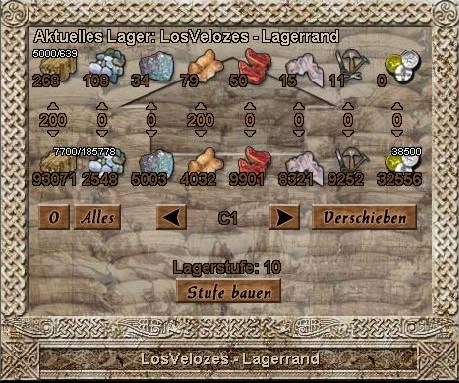Storing resources
Each town can only store 100 resources and 500 talers per citizen in the marketplace, where cloth counts as 3 and tools count as 5 resources. A town can build warehouses to expand the storage capacity. Each town can construct a maximum of 2 warehouses and an additional warehouse for each land extension. In addition to that, a town can construct a treasury to store talers. All buildings can be extended by multiple levels. Every level (out of a maximum of 10) of a warehouse can store up to 500 resources. Every level (out of a maximum of 20) of a treasury can store up to 50000 talers.
If the storage capacity of the marketplace is exceeded, the system automatically transports 50 resources to the warehouses (in this case cloth and tools count as 1 resource) every hour. But the town has to pay a price: only 45 resources will arrive in the warehouses and the other 5 are lost. If warehouses don't have enough capacity left either, all 50 resources will be lost. If there are too many talers in the marketplace the system will transport 1000 talers to the treasury every hour, as long the treasury has enough capacity.
Routing of resources
- resources earned by playing games are delivered to the marketplace.
- resources needed for production (weaving-mill, forge, laboratory) are taken out of the warehouses. The production result is delivered to the marketplace.
- trading at the market and through the town hall can only be done using the resources in the warehouses.
- building sites are primarily supplied using the resources in the warehouses.
Using the warehouse

The top row shows the amount of resources of each type which are stored in the warehouse you've entered. The white numbers on the left show the total capacity / used capacity of this warehouse
By clicking on the black arrows you can switch between the marketplace (Cxxx), other warehouses, the treasury and the contribute option.
For example, if you want to transport resources from the marketplace to a warehouse, first enter that warehouse and use the arrows to select the marketplace. After that the large arrow in the background of the image has to be set such that resources are transported from the marketplace to the warehouse or the other way around. To do that click on the top (or bottom) row of resources; the arrow will then change to that direction. The number of resources to transport can be set using the small arrows (similar to the town hall). The button marked 0 will set all numbers to 0, the arrow pointing upwards will increase the amount by 1, the arrow pointing downwards will decrease the amount by 1. Large amounts can be set using the right mouse button (per 10) and combinations with the shift key (left mouse button - 100, right mouse button - 1000). Click on the "Verschieben" button to actually transport the resources.
The "0" button resets all entered amounts. Click on the "Alles" button to set all resources ready for transport.
The picture above shows 200 wood and 200 wool ready for transporting from the marketplace to the warehouse named "Lagerrand".
The storing and moving of goods can be done by all town council members.
Also notice that:
- the storage capacity of a warehouse can't be exceeded and remember that cloth takes up 3 slots and tools 5!
- no resources can be stored in the treasury and no taler can be stored in the warehouses.
The treasurer can extend a warehouse or a treasury with one level by clicking on the "Stufe bauen" button. Warehouses can consist of 10 levels at the most and the treasury of 20 levels.
